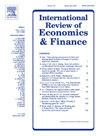Can digital inclusive finance suppress energy ecological footprint? moderated mediation effect test based on technological innovation
IF 5.6
2区 经济学
Q1 BUSINESS, FINANCE
引用次数: 0
Abstract
Within the context of energy conservation, emission reduction, and the development of digital inclusion financial (DIF), this study explores the relationship between DIF and the energy ecological footprint (EEF). Using panel data from 30 provinces in China spanning 2011 to 2021, it employs a moderated mediation effect model to empirically analyze the mechanisms through which DIF affects the EEF. The findings reveal that DIF can mitigate the growth of the EEF. Specifically, it achieves this by promoting industrial structure upgrading, which in turn curbs EEF expansion. Furthermore, technological innovation enhances the positive impact of DIF on industrial structure upgrading, thereby amplifying the suppressive effect of industrial transformation on the EEF. Additional analysis highlights that regional difference—such as government digital governance capacity, environmental and financial regulations, digital infrastructure development, and digital usage—significantly influence the extent to which DIF inhibits EEF growth. The study also finds that DIF not only fosters economic inclusiveness but also demonstrates an energy ecological inclusiveness effect. Its marginal utility is particularly pronounced in regions with lower economic development and higher EEF. This research contributes to a deeper understanding of the theoretical linkage between DIF and the EEF. It also provides valuable references and decision-making insights for leveraging DIF to enhance energy efficiency and support the achievement of the “dual-carbon” goals.
数字普惠金融能否抑制能源生态足迹?基于技术创新的有调节中介效应检验
在节能减排和数字普惠金融(DIF)发展的背景下,本研究探讨了数字普惠金融与能源生态足迹的关系。利用2011 - 2021年中国30个省份的面板数据,采用有调节的中介效应模型,实证分析了DIF影响企业经济增长的机制。结果表明,DIF可以减缓EEF的生长。具体来说,是通过促进产业结构升级来实现这一目标,而产业结构升级反过来又抑制了东方经济的扩张。此外,技术创新增强了DIF对产业结构升级的正向影响,从而放大了产业转型对ef的抑制作用。其他分析强调,区域差异(如政府数字治理能力、环境和金融法规、数字基础设施发展和数字使用)显著影响了DIF抑制EEF增长的程度。研究还发现,DIF不仅促进了经济包容性,而且表现出能源生态包容性效应。它的边际效用在经济发展水平较低、EEF较高的地区尤为明显。本研究有助于更深入地理解DIF与EEF之间的理论联系。它还为利用DIF提高能源效率和支持实现“双碳”目标提供了有价值的参考和决策见解。
本文章由计算机程序翻译,如有差异,请以英文原文为准。
求助全文
约1分钟内获得全文
求助全文
来源期刊
CiteScore
7.30
自引率
2.20%
发文量
253
期刊介绍:
The International Review of Economics & Finance (IREF) is a scholarly journal devoted to the publication of high quality theoretical and empirical articles in all areas of international economics, macroeconomics and financial economics. Contributions that facilitate the communications between the real and the financial sectors of the economy are of particular interest.

 求助内容:
求助内容: 应助结果提醒方式:
应助结果提醒方式:


